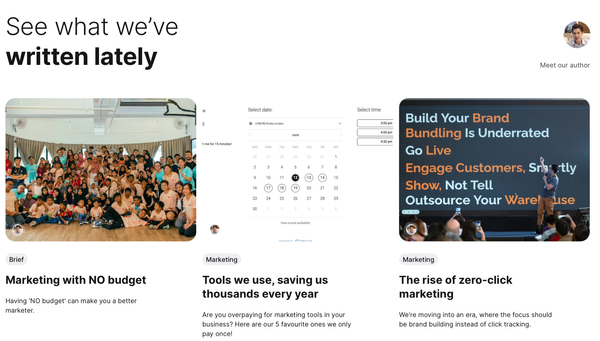In 2019, I was about to move into my new house and I wanted to buy a solid wood dining table. I visited a factory and browsed the many solid table tops that were on sale.
Here's the thing about solid wood. Every piece is unique with different dimensions and patterns. Eventually, I came across one. It's perfect – size, pattern, everything. I decided to take it.
"This one. Can you book it for me?", I said.
"Hmm, this one. Oh, this one is booked by another customer", said the seller.
"Oh. Is there any way you can sell it to us?", I said.
"Hmm, let me check. A bit hard la." the seller said.
"I'll make payment today. No need to give me a discount".
Long story short, I paid for the table there and then. The table was only sent to me 4 months later when my home renovation was completed.
Looking back, I now realize the seller had psychologically triggered a sale from me – by playing scarcity. There was probably no one who booked the table.
So today, I'll share 8 psychological triggers I've learned that you can use to nudge your customers to buy now instead of later. And of course, I hope you use them without lying to your customers.
Let's start.
1/ Scarcity
Just like how the factory seller made me pay for the solid table immediately, inducing scarcity is probably the most used tactic to get people to take action now.
People might want your product, but they need a bit of nudge to take action now.
- Limited time only.
- Price good only for today.
- Promotion ends today.
Just make sure to have a good reason why there's scarcity. People need a good reason to believe that you're not bullshitting them. If your reason is valid, they'll usually be convinced to take action immediately.
2/ Future pacing
Show your customer what their path will look like – in a month, 6 months, or a year from now.
Show them what it means to be successful or to have solved their problem – a week, month, or year from now. Don't forget to show them the pain of not taking action.
Imagine selling a chair that cures backaches:
Imagine this. You'll experience no more backache this weekend. In the next 2 weeks, you'll even forget you had a backache problem. In fact your posture will be so much better that by the end of the month, you'll be back to playing football.
And what if you didn't buy this today?
Imagine still having back pain. 6 months from now the pain becomes so unbearable that you end up needing a surgery.
3/ Limited Space
Having limited space at Underdog Con was what worked for us.

Here is who's coming. There's only space for 120 people. This way, we're able to create a truly personal and high-quality conference.
The secret is to figure out what limits you can put on your offer.
- Limited units left
- Limited spots
- Limited free bonuses
If there are no limits – your product is available at all times and anything. People just wouldn't have the motivation to take action now.
4/ Risk-reversal
Once, I wanted to buy a 2nd hand camera. I was afraid of the risk. But then I found out the seller runs a camera shop. I could always go back to the shop if I found problems.
I bought the camera.
Risk reversal is about understanding every risk your market has, and then systematically taking those risks away.
If someone were to attend Underdog Con conference, what's the risk they might have?
- What if I go to this event, and it isn't useful?
- How do I know this would work?
- I joined other conferences before, and they were a waste of time. Why would this be any different?
As a marketer, you need to know every risk your customer faces and take it all away.
Here are some ideas to take away risk:
- Offer money-back guarantee. They generate more sales than the refund rates they produce. In most cases, it's safe to offer a money-back guarantee.
- Show social proof. If it works for other people, then it should work for me.
5/ Social Proof
People want to buy something that other people are buying.
It's the same reason why we want to go to restaurants where there's a line of people.
You know your product is going to be helpful for them. Now, you are trying to understand what will make them take action – at this moment.
- Show comments from other people, so they know they are not alone.
- Show any press mentions you have.
- Show reviews and conversations from past customers.

6/ The No-Brainer
When I marketed data science bootcamps, we had to show why the course was a no-brainer.
Why is it a no-brainer compared to going to university?
- Well, you get to your goal faster. (Get a data job)
- A fraction of what university costs
- Help to get into job interviews
- 24/7 chat support
- Money-back guarantee
Of course, they can study data science at a university. Only that it'll cost them a bomb and take years before they're can secure a job as a data scientist. Finally, if they don't want to do that, they can join a cheap Udemy course. But how are they going to know if it's going to work with no support?
Pro tip: Treat your market like educated people with lots of options. I tend to see marketers hide the fact that their customers have options. No! Educate them about their options and show them why yours is the better option.
7/ Tell Stories
Why do people like Daily CMO emails? (Ok not everyone, but there's a good number of people.)

That's because we tell a ton of stories.
What's the deal with stories? Why do they work?
That's because we're not able to stop reading or listening to a story when we start reading it. We want to close the loop. I wanna know the ending, goddamnit!
Try it: Tell someone a story, and then stop midway.
I strongly encourage you to tell stories about yourself.
It's easy to spot content marketing newbies. They share nothing about themselves. Everything they write is prim and proper.
The more experienced marketers are open and authentic. Sometimes the stories end in their successes, sometimes it end in their failure. That's OK. Because experienced marketers know we all respond to stories.
And that usually clinches the order.
8/ Liking and trust
People buy from organizations they like.
That's marketing! Marketing is simply the process of getting people to know, like, and trust you. At Daily CMO we do this by telling stories. Everytime people open our emails they'll be wondering, what crazy story am I going to read today?
Here's the secret to being likable: Be genuinely interested in the other person. Talk less, listen more.
But how do you apply that to a business? By being empathetic. Do your customers feel heard? Is the business innovating and producing products for its audience?
A company that does this well is Zappos.
All this combined becomes very powerful.
You don't want people to say, "Oh, I'll get this later." When they say later, they'll almost never buy.
But don't forget the reason we use these psychological triggers.
It's not because we're sleazy marketers. We use these triggers to help our customers make a decision and improve their lives.
Which one is your favorite trigger? Drop your comments.
Grow a 2nd revenue with your brand.
Did you know it's possible to grow your brand and build a 2nd revenue stream with your current brand, selling merchandise?
We're launching a new product to help creators and businesses build a new revenue source.

More details on this soon. For now, I'd love for you to try it out. There's no risk. Create and sell your brand merchandise with no money down. I will personally help the first 5 businesses who sign up launch their merchandise campaign.
Just sign up for an account at Yeefu and reply to my email here.







